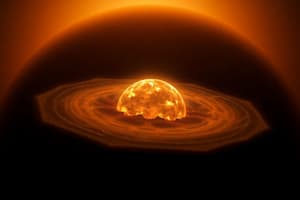Podcast
Questions and Answers
What primarily forms the Sun's energy through fusion?
What primarily forms the Sun's energy through fusion?
- Oxygen splitting into hydrogen
- Hydrogen transforming into helium (correct)
- Helium combining into heavier elements
- Carbon burning into nitrogen
Which of the following correctly describes the composition of terrestrial planets?
Which of the following correctly describes the composition of terrestrial planets?
- They are larger than gas giants
- They orbit the Sun in the outer Solar System
- They are composed of mostly gas and liquids
- They have solid surfaces (correct)
Which planets in the Solar System are categorized as gas giants?
Which planets in the Solar System are categorized as gas giants?
- Earth and Mars
- Jupiter and Saturn (correct)
- Mercury and Venus
- Neptune and Uranus
What is the heliopause?
What is the heliopause?
Approximately what percentage of the Solar System's mass is contained in the Sun?
Approximately what percentage of the Solar System's mass is contained in the Sun?
Which of the following objects is NOT classified as a dwarf planet?
Which of the following objects is NOT classified as a dwarf planet?
Which belt is located between Mars' and Jupiter's orbits?
Which belt is located between Mars' and Jupiter's orbits?
What is the theorized outermost region of the Solar System that is a source for long-period comets?
What is the theorized outermost region of the Solar System that is a source for long-period comets?
Study Notes
Formation and Structure of the Solar System
- The Solar System formed approximately 4.6 billion years ago from the collapse of a dense region in a molecular cloud.
- Contains the Sun, which is a G-type main-sequence star, and a protoplanetary disk of orbiting objects.
- The Sun generates energy through hydrogen fusion into helium, releasing energy visible from its outer photosphere.
Major Components
- The Solar System consists of eight main planets:
- Four terrestrial planets: Mercury, Venus, Earth, Mars (solid surfaces)
- Two gas giants: Jupiter, Saturn (no definite surface, composed mainly of gases and liquids)
- Two ice giants: Uranus, Neptune (similar composition to gas giants)
- Over 99.86% of the entire Solar System's mass is contained within the Sun.
Dwarf Planets and Smaller Bodies
- The Solar System is known to have at least nine recognized dwarf planets:
- Ceres, Orcus, Pluto, Haumea, Quaoar, Makemake, Gonggong, Eris, and Sedna.
- Hosts a vast collection of small bodies including asteroids, comets, centaurs, meteoroids, and interplanetary dust clouds.
- Significant regions include:
- Asteroid belt between Mars and Jupiter.
- Kuiper belt beyond Neptune's orbit.
Natural Satellites and Solar Wind
- Six planets and all seven dwarf planets are known to possess natural satellites, commonly referred to as moons.
- The Solar System is continuously exposed to the solar wind, a stream of charged particles emitted by the Sun, extending to form the heliosphere.
- The heliopause, located 75–90 astronomical units from the Sun, marks the boundary of the Solar System beyond which interstellar space begins.
Outer Regions and Nearby Stars
- The hypothesized Oort cloud, believed to be the source of long-period comets, extends from approximately 2,000 to 200,000 astronomical units from the Sun.
- The closest star system, Proxima Centauri, is situated about 4.25 light-years or 269,000 astronomical units away, both stars belonging to the Milky Way galaxy.
Studying That Suits You
Use AI to generate personalized quizzes and flashcards to suit your learning preferences.
Description
Explore the origins and components of the Solar System through this quiz. Learn about the formation process, the eight main planets, and the various dwarf planets and smaller bodies that populate our cosmic neighborhood. Test your knowledge on the structure and major elements that define our Solar System.





